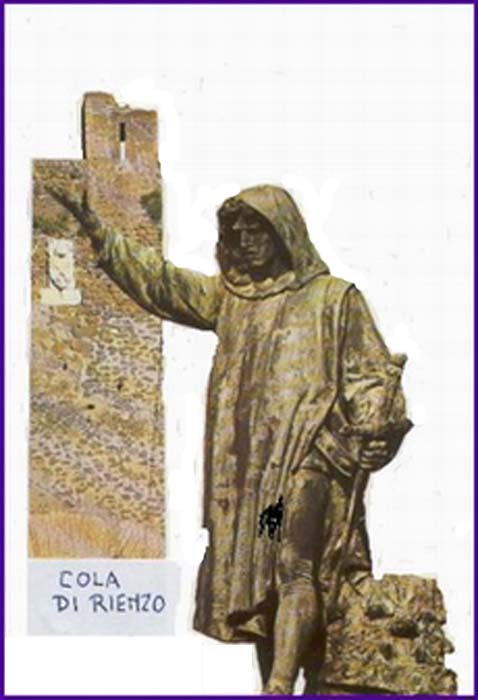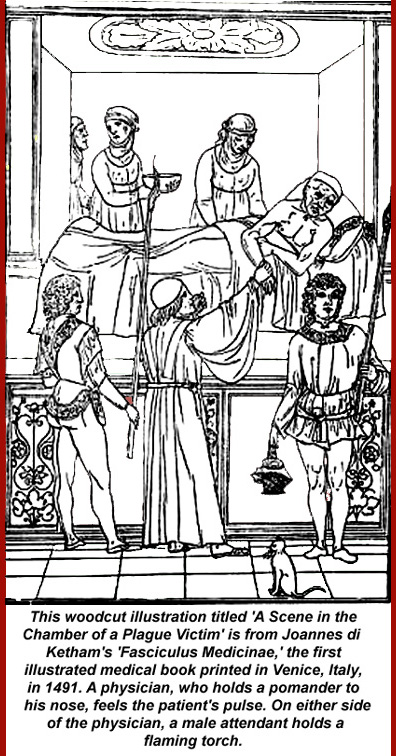ALRItkwRom303_10RienPlague.htmlCola, Plague, Other Opportunities
When did the Medieval period end?
Just as it didn’t "begin", it didn’t really end. History simply doesn’t stop and then restart as something else.
History courses do begin and end, however, so historians invent and embrace "periods".
Most historians say that the European Medieval period ended with The Plague and its aftermath or that the Roman/Italian period ended with Cola di Rienzi and his aftermath.
[and remember that Italy was invented, formed, discovered during the Medieval period.]
Much of what we know about Cola di Rienzi is semi-legendary.
Petrarch, who transmitted and controlled some of the initial information was an interested party — some say that Petrarch may have manipulated Rienzi as part of the Guelph/Ghibelline conflict and/or as part of the Colonna / Orsini rivalry in Rome and/or as an agent for the Avignon Pope (a Frenchman) who really wanted to stay in Avignon.
If Petrarch really was the puppet-master, he then was the first Renaissance man
The Rienzi Story: A cynic might find a different story: Rienzi’s younger brother was killed in a dust-up between the Orsini and the Colonna. Rienzi, who had been a client of the Colonna, asked for and was promised revenge by the Count, but the count reneged when he discovered that Rienzi’s younger brother was killed by Colonna’s own lieutenant.
Rienzi rallied the people to oppose/expel all of the nobility — i.e. both the Orsini and Colonna factions and their various allies.
The nobility fled — perhaps because they had previously had to send most of their urban retainers to the countryside to fill in behind a starving peasant population.
Rienzi antagonized the population and the church, and he fled when the nobles returned with their minions.
After wandering and imprisonment, Rienzi was returned to Rome under the sponsorship of Petrarch and the Avignon Papacy.
Rienzi soon antagonized the population again by taxes and his own excesses Including bathing in the St. John Lateran baptismal font.
The nobility moved against him, and the antagonized "popolo" didn’t rally to his aid.
Rienzi was murdered by the nobility on the steps of the Palazzo Senatorio — he was then hacked by other nobles and thrown to the dogs.
End of Revolution.
Post-Rienzi exploitation of the legend After Rienzi was shocked by the death of his brother he was manipulated through the above chain of events by Petrarch and other Avignon Papal partizans(/agents?) who wanted to bring the nobility down a notch or two. After that was accomplished, the church withdrew its support and Rienzi was discarded.
Petrarch, as poet laureate and papal house philosopher made a pretty speech.
Later dictators (universally ignoring how Rienzi ended) made him an heroic icon. Napoleon, Hitler, and Mussolini all glorified Rienzi as their own heroic predecessor — they would finish his mission and restore the ancient Roman Empire. Napoleon had a copy of de Cerceau’s Rienzi book with him at Waterloo. Hitler told friends and the heirs of Wagner that Wagner’s opera, Rienzi, had been the motivational force of his life. (Wagner’s opera was based on Bulwer-Lytton’s novelization of the Rienzi story (full text).
Mussolini had Gabriele d’Annunzio, the author of the most famous Italian glorification of Rienzi (Italian text), as his own philosopher/poet laureate — the relationship paralleled that of Rienzi with Petrarch.

